Enhancing Laundry with Soap and Vinegar: A Detailed Guide
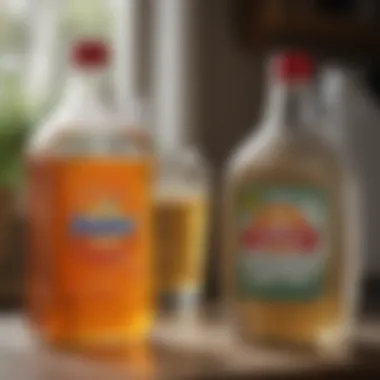
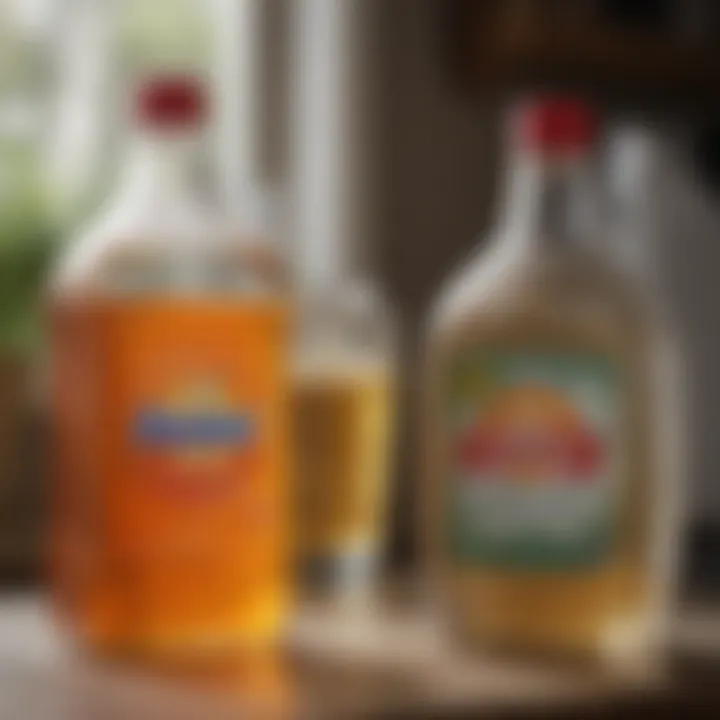
Intro
In the realm of domestic chores, laundry stands out as a routine drudgery many of us endure. But what if the everyday task of washing clothes could be elevated to a science? This exploration into the combined powers of laundry soap and vinegar reveals not just their duo's benefits for cleaning, but the intriguing chemistry behind it all. As we dissect the multifaceted relationship between these household staples, we will shine a light on how they can elevate your laundry game, tackle stubborn stains, eliminate nasty odors, and enhance the longevity of your fabrics.
By understanding the functions of each component, housewives and homeowners alike can tap into the unique benefits of this synergistic approach, transforming mundane laundry tasks into an opportunity for effective household management. Moreover, the relevance of adopting such eco-friendly methods is becoming more pronounced. As sustainability takes center stage in discussions about domestic life, you will discover how integrating vinegar into your laundry routine can contribute to a greener planet, one load at a time.
As we journey through this article, we’ll take a close look at the practical applications, share valuable safety considerations, tackle some common misconceptions, and offer a comprehensive guide to optimizing laundry practices. Get ready to rethink the way you wash clothes.
Current Trends
The growing movement towards sustainable living has sparked renewed interest in natural cleaning agents, such as vinegar. This shift is not merely a fad; it speaks volumes about a collective desire for transparency in what we use in our homes. Consumers are becoming increasingly aware of ingredients, often opting for products that offer both effectiveness and eco-friendliness.
Color Palettes
The modern laundry room often reflects soothing color palettes that evoke cleanliness and relaxation. Whites, soft blues, and muted grays are trending, providing a calming backdrop to the sometimes chaotic activities associated with this area of the home. The choice of color also highlights the simplicity of using straightforward, natural substances like vinegar in our daily routines.
Popular Styles
As trends morph, laundry spaces are now designed with more than just function in mind. Homeowners are getting creative, integrating open shelving adorned with decorative jars of laundry soap and vinegar. These design choices promote accessibility while keeping aesthetics in the forefront. It combines style with practicality, making your laundry area an integral part of your home rather than a forgotten corner.
Practical Applications of Laundry Soap and Vinegar
When it comes to laundry, the combination of soap and vinegar offers practical solutions to common problems. Let’s delve deeper into some powerful merging applications:
- Odor Removal: Washing clothes with regular detergent might not always cut through smells, especially for those who engage in vigorous activities. Adding vinegar to the wash cycle can neutralize funky odors without leaving a lingering vinegar scent. And yes, the science backs it up; vinegar acts as a natural deodorizer.
- Stain Treatment: The dynamic duo also shines when it comes to tackling stubborn stains. Pre-soaking clothes in a mixture of laundry soap and vinegar can work wonders. The acetic acid in vinegar helps to break down soil and stains, while the soap traps dirt particles, leading to more effective cleaning overall.
- Fabric Softening: Many still reach for commercially available fabric softeners, but vinegar can do that job too. Adding a little vinegar during the rinse cycle softens fabrics naturally while helping to remove any remnants of detergent.
"The combination of vinegar and soap is an age-old trick that marries efficiency with simplicity, allowing homeowners to adopt practices that are not only effective but eco-friendly."
Safety Considerations
While both laundry soap and vinegar are safe for the most part, there are some considerations to keep in mind. For instance, never mix vinegar with bleach, as the chemical reaction can release harmful gases.
Additionally, some fabrics may not react well to vinegar, particularly delicate materials like silk or certain synthetic blends. It’s always best to test a hidden area first.
Common Misconceptions
Despite the growing popularity of using vinegar in laundry routines, several myths persist:
- Vinegar damages clothes. Not true. When used correctly, vinegar can enhance fabric longevity.
- It won’t get clothes clean. Counter to this belief, many find that vinegar, when combined with detergent, actually improves cleaning efficacy.
As we continue exploring this exciting topic, we’ll uncover additional benefits and share more methods for integrating these powerful cleaning agents into everyday routines. Together, let’s strip away the layers of misconceptions and embrace a cleaner, greener way to do laundry.
Foreword to Laundry Soap and Vinegar
Understanding how laundry soap and vinegar can work together is more than just a household hack; it’s about tapping into a synergy that enhances cleaning results while being mindful of our environmental impact. By exploring this topic, we uncover the myriad benefits that arise not only from using these two products in tandem but also from appreciating their individual roles in household care.
Both laundry soap and vinegar each hold a unique place in our cleaning routines. Laundry soap focuses on breaking down dirt and grease, while vinegar, with its gentle acidity, offers properties that help tackle stains, odors, and even fabric softening. This article dives into these fundamental concepts, shedding light on the specific elements and benefits associated with each.
Moreover, we will gradually examine practical considerations: how to leverage these products for optimal results in the washing machine without causing harm to fabrics.
As we delve into the essentials of laundry soap, we discover that not all products are created equal and that the right soap can make a difference. We will also uncover the role of vinegar—a common staple in many kitchens—as not just a seasoning but a powerful ally against the challenges of laundry day.
"When life gives you dirty laundry, mix up some soap and vinegar to make it right."
In the coming sections, you will learn the chemistry behind these cleaning agents, understand their benefits, and get practical applications for incorporating them into your laundry routine. The insights shared here will endeavor to empower housewives and homeowners alike, equipping them with knowledge to refine their cleaning methods through the power of synergy.
Essentials of Laundry Soap
Laundry soap is more than just a product found on supermarket shelves; it is a combination of surfactants, builders, and enzymes that help lift dirt from fabrics. Surfactants break down oil and grime, allowing them to be washed away effectively. Builders enhance this process by softening water, making the soap more effective.
The types of laundry soap you choose can affect not only the cleanliness of your clothes but also their longevity:
- Liquid detergents: Ideal for pre-treating stains and dissolving quickly in water, making them versatile for all water types.
- Powdered detergents: Often more cost-effective and suitable for heavy-duty cleaning, especially in hard water conditions.
- Pods: Convenient and mess-free, these pre-measured capsules offer an easy solution for busy households.
Furthermore, it is crucial to consider any additives or fragrances in laundry soaps, as they can impact both the cleanliness of the garments as well as individual sensitivities. Consistent use of the appropriate kind and amount of laundry soap can yield a noticeable difference in freshness and cleanliness, an outcome no homeowner should overlook.

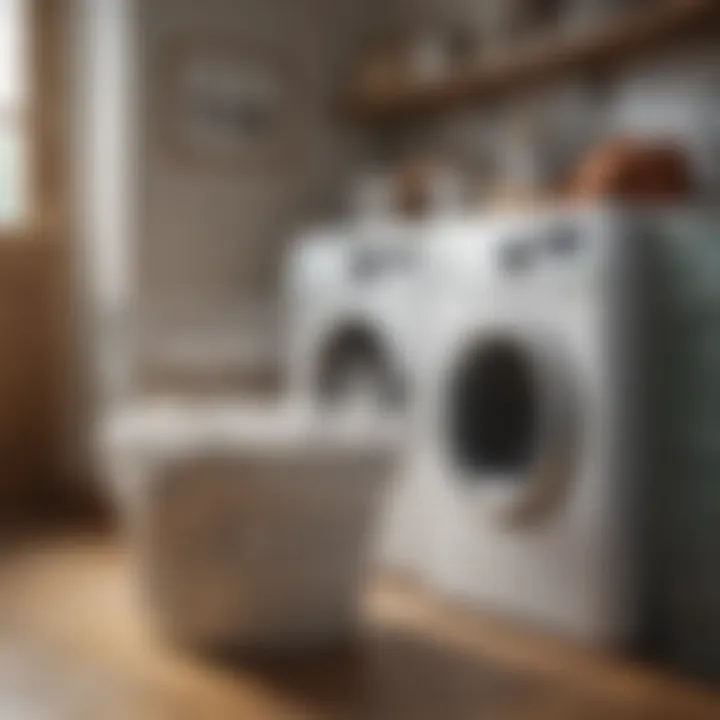
Role of Vinegar in Household Cleaning
Vinegar, often overlooked as a mere salad dressing ingredient, has gained a reputation as a cleaning powerhouse. With its acetic acid composition, it neutralizes odors, acts as a natural fabric softener, and aids in combating mineral buildup in washing machines.
Using vinegar in the laundry process not only boosts cleaning efficiency but also extends the life of fabrics. Here are several roles vinegar plays in household cleaning specifically related to laundry:
- Odor Combatant: Vinegar effectively neutralizes unpleasant odors from fabrics and washing machines, making it an excellent choice for tackling musty smells.
- Stain Remover: For stubborn stains like red wine or grease, a vinegar soak can yield impressive results.
- Static Reduction: The acidic nature of vinegar helps reduce static cling, keeping those clothes looking stellar.
- Whiten Whites and Brighten Colors: Adding vinegar to your wash can help maintain the brightness of your colors while preserving white fabrics without the harshness of bleach.
In our forthcoming sections, we will discuss the science behind these processes and provide practical tips for using vinegar effectively in conjunction with laundry soap.
Understanding the Chemistry
In the realm of household cleaning, the chemistry behind the products we use plays a pivotal role in achieving effective results. When discussing laundry, the interaction between laundry soap and vinegar becomes especially relevant. A deeper understanding of this synergy not only highlights the benefits but also addresses important considerations about fabric care, ecological footprints, and the science behind stain removal.
By discerning how each component functions at a molecular level, one can tailor laundry practices that elevate cleaning efficiency, foster sustainability, and preserve fabric longevity. Understanding the chemistry empowers housewives and homeowners alike to make informed decisions, enhancing their regular routine into a regime that effectively fights stains and bad odors, while being conscious of their environmental impact.
Chemical Composition of Laundry Soap
Laundry soaps come in various forms—liquids, powders, and pods, each designed with unique chemical formulations. Generally, they contain surfactants, enzymes, and additives, enabling them to tackle different types of dirt and stains.
- Surfactants are the backbone of laundry soap. They work by reducing the surface tension between water and grease, allowing them to mingle. This is crucial as it helps lift dirt away from fabrics, making it easier for the washing machine to rinse it away.
- Enzymes play a specific role in breaking down proteins, starches, and fats in stains. For instance, proteases tackle protein-based stains like blood or egg, while amylases deal with starchy residues.
- Additives can enhance formulas, providing properties like color protection or foam control, ensuring a thorough clean without damaging fabrics.
Combining these components creates a powerful tool for fighting stains. However, it's essential to use them wisely. Overloading laundry with soap can lead to residue buildup, which might actually attract dirt instead of removing it. This opens the door to longer wash cycles and potential harm to delicate fabrics.
The Acidity of Vinegar: Implications for Fabric Care
Vinegar is often overlooked in laundry routines. Yet, its efficacy largely derives from its acidity, primarily attributed to acetic acid. This component works wonders when it comes to fabric care, offering multiple benefits:
- pH Balancing: Most laundry soaps are alkaline. Introducing vinegar balances pH levels, making it gentler on fabrics while boosting cleaning efficiency. This balance helps to restore the vibrancy of colors and maintain the integrity of the fabric over time.
- Stain Removal: Vinegar tackles mineral deposits and soap scum, common offenders in stubborn stains. Its acidic nature breaks down residues left behind by hard water, facilitating a cleaner finish.
- Odor Neutralization: The strong scent often associated with fabric softeners can be masked by vinegar’s unique smell, but more importantly, it neutralizes unpleasant odors caused by mildew or food stains. Tossing in a cup of vinegar during the rinse cycle can leave clothes fresh and without that detergent smell.
With proper understanding and application, integrating vinegar into laundry routines—even with your standard laundry soap—can enhance results substantially. It transforms a mundane chore into a more effective and satisfying process that benefits both fabrics and the environment.
Benefits of Using Vinegar with Laundry Soap
The integration of vinegar with laundry soap is gaining traction among those pursuing effective and conscious cleaning practices. This collaboration acts as a double-barreled approach to tackle the common challenges faced during laundry, providing both efficacy and an eco-friendly alternative. There’s a plethora of benefits that this duo brings to the table, from enhanced stain removal to odor neutralization, and even softening fabric without the need for commercial softeners.
Stain Removal Efficiency
When it comes to fighting stubborn stains, vinegar and soap make quite the team. Vinegar’s natural acetic acid offers properties that can break down a variety of stains, including grease, wine, and even mud. What many might not realize, however, is the efficiency gained from using vinegar alongside laundry soap. The soap works to lift grime and dirt while the vinegar penetrates deeper into fabric fibers, loosening the grip of the stains. To maximize effectiveness, it's smart to pre-treat tough stains with a mix of both before tossing the items into the wash.
"Combining vinegar and laundry soap is like having your cake and eating it too; you get to enjoy the benefits of both without a hefty price tag."
This synergy is not just a theory; numerous testimonials support it. Many individuals have peace of mind knowing they can achieve impressive stain removal results without relying solely on harsh chemicals. Rather, they harness ingredients they already have in their homes.
Odor Neutralization
Have you ever removed laundry from the washing machine only to be hit with a wave of musty or stale odors? Vinegar comes to the rescue once again. Its inherent ability to neutralize odors helps combat common laundry smells that can arise from tough bacteria or leftover residue. By utilizing vinegar in a wash cycle, it helps to ensure that clothes emerge fresh as a daisy—without chemical fragrances that artificial softeners typically leave behind.
Simply add a cup of vinegar during the rinse cycle, and you may find that pesky smells vanish into thin air. Vinegar's capability to absorb odors rather than just mask them makes it a game-changer in the laundry arena, leaving garments smelling like they were just sun-dried.
Fabric Softening Characteristics
In addition to stain removal and odor combatting, another aspect worthy of note is the natural softening qualities of vinegar. Unlike traditional fabric softeners packed with synthetic additives, vinegar is gentler and less likely to cause allergic reactions or skin irritations. When used correctly, it can result in softer fabrics without the waxy residue often found in commercial products.
By utilizing vinegar, laundry can maintain that fluffy, fresh feel that everyone desires. Its use in laundry routines can prolong the lifespan of the fabric too, reducing wear and tear over time.
When considering all these benefits, it becomes clear that the versatility of vinegar—when paired with laundry soap—offers a solid way forward for those looking to optimize both their cleaning practices and personal care routines.
Practical Applications
The intersection of laundry soap and vinegar presents practical applications that can greatly enhance their effectiveness in household laundry. Many homeowners look for solutions that are not only effective but also safe and environmentally conscious. This section delves into how to implement these methods effectively, covering mixing ratios, application techniques, and the use of vinegar as a fabric sanitizer. Understanding these practical applications allows users to streamline laundry tasks while achieving impressive results.
Mixing Ratios for Optimal Results
To harness the full potential of vinegar in conjunction with laundry soap, it’s crucial to develop the appropriate mixing ratios. A common rule of thumb is to use about 1 cup of vinegar per 1 load of laundry in the fabric softener dispenser. This amount strikes a balance between enhancing stain removal and odor neutralization without overwhelming the fabrics.
However, it’s wise to consider the specific cleaning needs of your laundry. For heavily soiled items, like children’s play clothes or work uniforms, increasing the vinegar amount to 1.5 cups may yield better results. On the other hand, for delicate fabrics like silk or many synthetics, reducing the amount to 1/2 cup could prevent any potential adverse reactions.
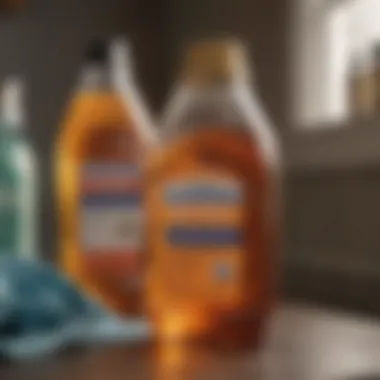

The vinegar should ideally be mixed with laundry soap in the wash cycle rather than directly on the fabric, ensuring it distributes evenly. Here’s a handy mixing guide:
- 1 cup vinegar for normal loads
- 1.5 cups for heavily soiled items
- 1/2 cup for delicate fabrics
Application Techniques for Stubborn Stains
Stubborn stains can turn a favorite garment into an unwelcome sight. When using vinegar alongside laundry soap, specific application techniques can work wonders.
- Pre-Treatment: For tough stains, such as grease or blood, mixing equal parts of vinegar and laundry soap directly and applying it to the stain before washing can be impactful. Let it sit for at least 15 minutes to allow the solution to break down the stain’s properties.
- Spot Cleaning: For localized stains, pour a small amount of undiluted vinegar directly on the stain, then follow with a dab of laundry soap. Gently rub the area with your fingers or a soft cloth to work in the solution.
- Hot Water Rinse: After treating a stubborn stain, run it through the washing machine with a hot water cycle. This helps in fully activating the cleaning agents in both vinegar and the soap.
These techniques not only tackle ground-in stains effectively but also utilize the natural properties of vinegar as a cleaning agent, offering a safer alternative to harsh chemical stain removers.
Using Vinegar as a Fabric Sanitizer
In an era where maintaining cleanliness seems more important than ever, the idea of using vinegar as a fabric sanitizer resonates with many. With its inherent antibacterial properties, vinegar can serve as a robust alternative to commercial fabric sanitizers.
To use vinegar effectively as a sanitizer, add 1 cup of white vinegar in the rinse cycle. This is ideal for items like bed linens and towels, which can harbor bacteria despite seeming clean. It’s a simple way to add an extra layer of protection without the use of synthetic chemicals.
- Key Benefits:
- Kills harmful bacteria and microorganisms
- Reduces static cling during the drying phase
- Leaves fabrics soft without the need for fabric softeners
"Using vinegar in laundry routines not only serves functionality but also aligns practices with sustainable cleaning habits."
By incorporating these practical applications, readers can enhance their laundry processes significantly while also being conscientious about the types of products they use on their fabrics. As one develops a routine that integrates these methods, the results can transform typical laundry drudgery into an opportunity for efficient and eco-friendly cleaning.
Safety Considerations
When it comes to household cleaning, safety should always be at the forefront of our minds. This is especially true when considering the combination of laundry soap and vinegar. Understanding the nuances of their interactions can alleviate potential concerns and enhance overall effectiveness. A clear comprehension of safety considerations ensures that users can implement these cleaning agents with confidence.
Compatibility with Different Fabrics
Not all fabrics are created equal, and when it comes to treating them with vinegar and laundry soap, compatibility is key. Many people often overlook how different materials can react. For instance, while cotton and polyester generally tolerate vinegar well—allowing for effective deodorization and stain removal—more delicate materials like silk and wool might suffer from vinegar's acidity.
Testing on a small, hidden area can save a lot of headaches down the line. Always remember to check care labels; they often provide specific instructions. If you're unsure, err on the side of caution. Washing items in cold water with a mild soap might be a good first step before introducing any vinegar concoctions. Some fabrics just might not take kindly to the acidity, so if caution is your mantra, it’s a good practice to dive into the cloth's specific requirements. Moreover, washing mixed fabric items may lead to uneven cleaning results due to the different responses of the materials to the vinegar.
Potential Reactions with Other Cleaning Products
While combining laundry soap and vinegar can yield impressive results, one must heed caution against mixing these substances with others. The world of cleaning agents is vast, and reactions may produce unwanted outcomes or even harmful fumes.
For example, mixing vinegar with bleach can lead to a potentially hazardous gas called chlorine gas, which can irritate the eyes and respiratory system. Similarly, using vinegar with certain commercial detergents—especially those containing enzymes—might neutralize their effectiveness. It may cause fabric deterioration or discoloration.
To avoid these complications, it's best to stick to using laundry soap and vinegar alone. This approach not only optimizes cleaning potential but also minimizes risks, leaving you with peace of mind while tackling stubborn stains.
"A little knowledge can go a long way in household safety—learn the ropes before diving in!"
In summary, understanding the safety considerations regarding the compatibility of fabrics and interactions with other cleaners will help elevate your laundry game altogether. Knowing what to combine, and what to avoid, ensures a seamless cleaning experience whilst maintaining the integrity of your garments.
Environmental Impact of Using Vinegar
When discussing the environmental impact of laundry practices, vinegar stands out as a noteworthy player. It not only champions cleaning but does so in a way that aligns with eco-friendly initiatives. The traditional laundry soaps often contain potent chemicals that can have adverse effects on both human health and the environment. In contrast, vinegar offers a simple, yet effective alternative that satisfies the growing demand for sustainable living. Understanding its benefits is essential for anyone keen on reducing their environmental footprint while maintaining clean clothes.
Vinegar as a Eco-Friendly Alternative
Vinegar is primarily made from fermented ethanol, making it a biodegradable substance. Unlike many commercial cleaning agents filled with synthetic fragrances and harsh chemicals, vinegar is naturally derived. Its acidic nature helps break down grime and kill bacteria without the need for additional toxic components. This makes it an excellent choice for those attempting to lead an environmentally conscious lifestyle.
Some key points about vinegar as an eco-friendly alternative include:
- Non-toxic: Since vinegar doesn't contain harmful chemicals, it is safer for both the user and the environment.
- Versatile: Beyond laundry, vinegar can be used in a variety of household cleaning applications, reducing the need for multiple cleaning products.
- Cost-effective: Generally, vinegar is cheaper than manufactured laundry detergents, making it an economical choice.
Using vinegar for laundry helps alleviate some of the pollution associated with cleaning products. Many household products contribute to the buildup of phosphates in water bodies, harming aquatic life. In utilizing vinegar, you are cutting down on these contributions dramatically.
Reducing Chemical Waste in Laundry
In a world where plastic waste and chemical disposal are looming threats, every small action counts. By incorporating vinegar into laundry routines, householders can significantly decrease the amount of chemical waste they produce. It's not just about the product itself, but also about how it impacts laundry habits when folks choose a less harmful cleaner.
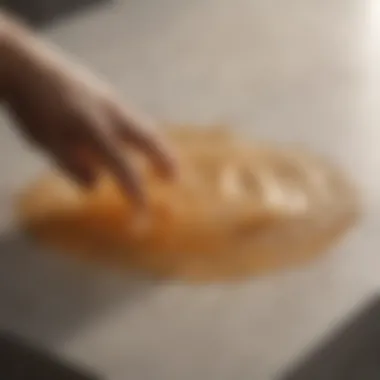
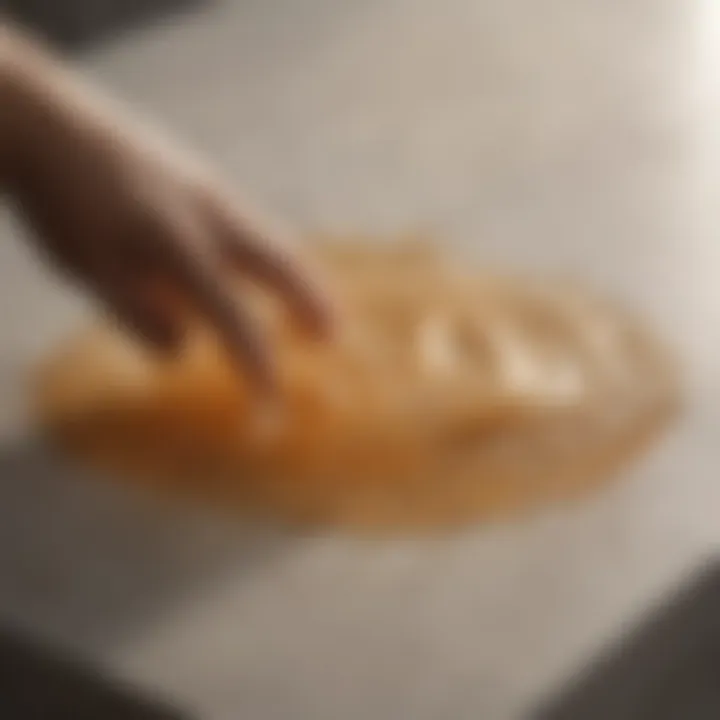
- Less Packaging: Vinegar usually comes in simple bottles compared to commercial laundry soaps that often come in multi-layer plastic packaging, contributing to landfill overflow.
- Diminished Chemical Discharge: The releases that come from washing clothes with conventional soaps often unsettle ecosystems in waterways. Vinegar, on the other hand, minimizes this risk when used as a replacement or supplement.
As more households turn to this natural aid, the overall need for chemical-laden products decreases, leading to healthier homes and communities. By switching to a vinegar-based laundry regimen, one actively participates in preserving the environment for future generations while ensuring cleaner clothes.
"Every small action can contribute to a larger change in our environment. Vinegar is a drop in the ocean that makes a difference."
In summary, utilizing vinegar in laundry not only enhances the cleaning process but also promotes a more sustainable approach to housekeeping. The change is simple but can lead to important environmental benefits ✨.
Common Misconceptions
Misconceptions surrounding the use of laundry soap and vinegar can lead to unnecessary confusion and misguided practices. Many people tend to overlook the advantages that this dynamic duo offers simply because of popular myths. By addressing these misconceptions, we can help clarify the real benefits of integrating vinegar with laundry soap and assure users about its safety and effectiveness in fabric care.
Vinegar and Fabric Discoloration Myths
One of the most persistent myths is that vinegar causes fabric discoloration. This idea is often passed down through generations, with many fearing that adding vinegar to the wash might lead to black socks turning light gray or vibrant shirts losing their pop. However, such fears are largely unfounded. The truth is that when used properly, vinegar acts as a natural fabric softener and can enhance the colors rather than dull them.
For instance, when washing dark colors, a half-cup of vinegar added during the rinse cycle can help set the dye, preventing bleeding and fading. A common practice is to combine it with cold water to mitigate the risk of any potential color changes. So, when washing those freshly bought, bright-colored clothes, consider a splash of vinegar to keep that color intact.
"Vinegar, in itself, does not have the properties that would lead to fabric discoloration; rather, misunderstanding its role creates unnecessary fear."
Perceived Ineffectiveness of Natural Ingredients
Some individuals assume that because vinegar and other natural ingredients don't come with flashy advertisements or scientific jargon, they must be less effective than conventional cleaners. This perception stems from a society that often equates effectiveness with high-cost products and complex chemical compounds. Yet, countless studies have shown that common household items like vinegar can effectively tackle stains and neutralize odors.
For example, the acetic acid present in vinegar breaks down stubborn food stains, making it an excellent choice for treating them before they set into fabric fibers. Additionally, vinegar often competes favorably with synthetic detergents on an effectiveness scale when it comes to deodorizing fabrics. Furthermore, many who are skeptical could try doing a side-by-side comparison of clothes washed with vinegar versus those washed with popular detergents. The results might just surprise them.
In summary, the belief that natural ingredients are less effective undermines the benefits of eco-friendly cleaning solutions. The effectiveness of vinegar in laundry persists, and it remains an accessible and reliable choice for many households.
Comparative Analysis with Other Stain Removers
In the world of household cleaning, stain removal is a critical topic that many homeowners grapple with. Understanding how vinegar and laundry soap stack up against other stain removers can be enlightening. This section unpacks the comparative effectiveness of this duo and how it fares alongside conventional stain removers.
Effectiveness Against Various Stains
When discussing stain removal, it’s essential to consider the type of stains that might grace your laundry. Whether it’s greasy spots from a favorite meal, red wine spills, or stubborn grass stains from a child's playtime, different stains require tailored approaches for effective removal.
Applying a blend of laundry soap and vinegar is often more holistic than relying solely on commercial stain removers. The vinegar acts as a natural acidic agent that can break down oil and grime, while laundry soap targets the physical dirt and odor. For example, when faced with a greasy food stain, a mixture of dish soap and vinegar can create a powerful remedy. The soap loosens the grease, and the vinegar helps lift it away from the fabric.
"Mixing vinegar with laundry soap isn’t just foolproof; it often outshines many of those pricey commercial stain removers."
On the other hand, commercial products often promote their effectiveness against certain specific types of stains. However, research has shown that not all are created equal—while some strong stain removers eliminate particular marks, they can also worsen the fabric’s condition over time. Thus, incorporating vinegar can be a game-changer, providing a two-pronged approach to tough stains while preserving the integrity of the fabrics.
Cost-Effectiveness and Efficiency
Now, let’s delve into dollars and cents. One major advantage of using vinegar in conjunction with laundry soap is the cost. While some stain removers can cost a pretty penny, cost-effective choices like vinegar deliver credible results with much less. Buying a bottle of white vinegar often feels like a drop in the ocean compared to investing in specialty cleaners or formulas. This makes it a favorite among budget-conscious housewives and homeowners, who appreciate both quality and savings.
Also, the efficiency of using vinegar and laundry soap is a crucial consideration. The time saved when stains are effectively removed can be substantial. Instead of multiple treatments or cycles through washing machines, a single wash with vinegar can potentially do the trick, cutting down on both water usage and energy consumption. This efficiency is not just good for the wallet; it also translates into a more sustainable approach to laundry.
Key benefits of cost-effectiveness and efficiency:
- Lower Overall Costs: Vinegar costs significantly less than commercial cleaners.
- Time Savings: Quicker removal of stains can reduce laundry time.
- Reduced Environmental Impact: Less water and energy use contribute to eco-friendliness.
In summary, while traditional stain removers may offer targeted benefits, the collaborative power of laundry soap and vinegar presents a strong alternative that merits consideration. Not only does it often outperform store-bought solutions when it comes to versatility and safety for fabrics, but it does so in a cost-effective manner that the savvy house owner will appreciate.
Closure: The Future of Laundry Practices
Understanding the role of vinegar in laundry routines goes far beyond just mixing two household staples. The integration of vinegar with laundry soap represents a significant shift towards more mindful cleaning practices. Such methods not only enhance the quality of laundry but also pivot us toward more environmentally conscious choices in our everyday lives. With growing concerns about chemical pollutants and health impacts, this approach embodies the movement towards sustainability that is becoming crucial in modern households.
Integrating Vinegar into Regular Laundry Routines
Adopting vinegar as a regular component of laundry routines requires a shift in mindset for many. Here’s how one might go about it:
- Substitution: Begin by replacing fabric softeners with vinegar. An addition of half a cup during the rinse cycle can soften fabrics naturally, eliminating the need for synthetic alternatives.
- Stain Treatment: For stubborn stains, consider a pre-soak with a vinegar solution before using laundry soap. A mixture of vinegar and water can do wonders for grease and sweat marks.
- Odor Control: Incorporating vinegar in the wash can tackle odors significantly. Use it in every wash, especially for gym clothes or items that tend to trap smells.
- Cleaning the Machine: It’s not just about clothes; adding vinegar to the washing machine itself can keep it fresh and clean, removing grime and buildup.
Incorporating vinegar into laundry processes not only enhances performance but also sends a message of eco-friendliness to the entire family. It can keep both fabrics and the conscience clean.
Emerging Trends in Sustainable Cleaning Solutions
The rise of green cleaning alternatives indicates a promising trend. There’s a marked movement towards embracing nature-derived ingredients over harsh chemicals in households. Key points to note include:
- Increased Awareness: Households are becoming more aware of the potential harm that some chemicals can inflict on both health and environment. This notion drives the demand for organic or natural cleaning agents like vinegar.
- DIY Solutions: The do-it-yourself trend provides a pathway for many homeowners who wish to create economic cleaning alternatives. Simple formulas including vinegar can replace expensive chemical products, proving that effective cleaning doesn’t have to come from a store.
- Community Shifts: Social platforms, such as Reddit, are buzzing with discussions around sustainable cleaning tips. More individuals are sharing experiences and solutions, furthering the practice of using simple household ingredients.
As households adapt to these changes, it's evident that a bright future for laundry practices is upon us—one where vinegar and laundry soap serve as pillars of cleanliness and care for the fabric of our lives.



